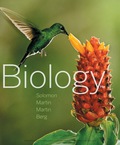
Concept explainers
Introduction: All sponges belong to a phylum called Porifera. They are the simplest animals with cellular level of organization. They have diverged from other animals early in the evolution. They have a very simple body structure composed of only two layers of cells. In between the two layers, a gelatinous region is present called mesohyl. The exchange of nutrient and waste material takes place through diffusion in sponges.
Answer to Problem 1TYU
Correct answer: Collar cells (chaonocytes) are characteristics of poriferans. Hence, the correct answer is option (a).
Explanation of Solution
Reason for the correct answer:
Option (a) is given as “poriferans”. The interior space of the body of poriferans is characterized by numerous canals lined with flagellate choanocytes. These cells help to capture food particles. They generate water flow through the body of the sponges. Hence, the correct answer is option (a).
Reasons for the incorrect answers:
Option (b) is given as “cnidarians”. Cnidarians are characterized by cnidocytes. Hence, option (b) is incorrect.
Option (c) is given as “most celomates”. Collar cells are characteristics of acelomate that is in poriferans. Hence, option (c) is incorrect.
Option (d) is given as, “lophotrochozoans”. Collar cells (chaonocytes) are not the characteristics of lophotrochozoans. Hence, option (d) is incorrect.
Option (e) is given as “ecdysozoans”. Ecdysozoans lack collar cells. Hence, option (e) is incorrect.
Hence, options (b), (c), (d), and (e) are incorrect.
Cnidarians are characterized by the presence of collar cells.
Want to see more full solutions like this?
Chapter 31 Solutions
EBK BIOLOGY
- Adaptations to a Changing Environment Why is it necessary for organisms to have the ability to adapt? Why is the current environment making it difficult for organisms like the monarch butterfly to adapt? Explain how organisms develop adaptations.arrow_forwardArtificial Selection: Explain how artificial selection is like natural selection and whether the experimental procedure shown in the video could be used to alter other traits. Why are quail eggs useful for this experiment on selection?arrow_forwardDon't give AI generated solution otherwise I will give you downwardarrow_forward
- Hello, Can tou please help me to develope the next topic (in a esquematic format) please?: Function and Benefits of Compound Microscopes Thank you in advance!arrow_forwardIdentify the AMA CPT assistant that you have chosen. Explain your interpretation of the AMA CPT assistant. Explain how this AMA CPT assistant will help you in the future.arrow_forwardwhat is the difference between drug education programs and drug prevention programsarrow_forward
- What is the formula of Evolution? Define each item.arrow_forwardDefine the following concepts from Genetic Algorithms: Mutation of an organism and mutation probabilityarrow_forwardFitness 6. The primary theory to explain the evolution of cooperation among relatives is Kin Selection. The graph below shows how Kin Selection theory can be used to explain cooperative displays in male wild turkeys. B When paired, subordinant males increase the reproductive success of their solo, dominant brothers. 0.9 C 0 Dominant Solo EVOLUTION Se, Box 13.2 © 2023 Oxford University Press rB rB-C Direct Indirect Fitness fitness fitness gain Subordinate 19 Fitness After A. H. Krakauer. 2005. Nature 434: 69-72 r = 0.42 Subordinant Dominant a) Use Hamilton's Rule to show how Kin Selection can support the evolution of cooperation in this system. Show the math. (4 b) Assume that the average relatedness among male turkeys in displaying pairs was instead r = 0.10. Could kin selection still explain the cooperative display behavior (show math)? In this case, what alternative explanation could you give for the behavior? (4 pts) 7. In vampire bats (pictured below), group members that have fed…arrow_forward
- Examine the following mechanism and classify the role of each labeled species in the table below. Check all the boxes that applyarrow_forward1. Define and explain the two primary evolutionary consequences of interspecific competitionarrow_forward2 A linear fragment of DNA containing the Insulin receptor gene is shown below, where boxes represent exons and lines represent introns. Assume transcription initiates at the leftmost EcoRI site. Sizes in kb are indicated below each segment. Vertical arrows indicate restriction enzyme recognition sites for Xbal and EcoRI in the Insulin receptor gene. Horizontal arrows indicate positions of forward and reverse PCR primers. The Horizontal line indicates sequences in probe A. Probe A EcoRI Xbal t + XbaI + 0.5kb | 0.5 kb | 0.5 kb | 0.5kb | 0.5 kb | 0.5 kb | 1.0 kb EcoRI On the gel below, indicate the patterns of bands expected for each DNA sample Lane 1: EcoRI digest of the insulin receptor gene Lane 2: EcoRI + Xbal digest of the insulin receptor gene Lane 3: Southern blot of the EcoRI + Xbal digest insulin receptor gene probed with probe A Lane 4: PCR of the insulin receptor cDNA using the primers indicated Markers 6 5 4 1 0.5 1 2 3 4arrow_forward

 Concepts of BiologyBiologyISBN:9781938168116Author:Samantha Fowler, Rebecca Roush, James WisePublisher:OpenStax College
Concepts of BiologyBiologyISBN:9781938168116Author:Samantha Fowler, Rebecca Roush, James WisePublisher:OpenStax College Biology: The Dynamic Science (MindTap Course List)BiologyISBN:9781305389892Author:Peter J. Russell, Paul E. Hertz, Beverly McMillanPublisher:Cengage Learning
Biology: The Dynamic Science (MindTap Course List)BiologyISBN:9781305389892Author:Peter J. Russell, Paul E. Hertz, Beverly McMillanPublisher:Cengage Learning Biology 2eBiologyISBN:9781947172517Author:Matthew Douglas, Jung Choi, Mary Ann ClarkPublisher:OpenStax
Biology 2eBiologyISBN:9781947172517Author:Matthew Douglas, Jung Choi, Mary Ann ClarkPublisher:OpenStax



